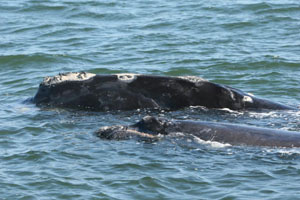Have Right Whale Questions? We've Got Answers.
Right whales are one of the biggest creatures on earth, but they are hard to see from the deck of a ship. Starting early November, right whales slowly make their way down the Atlantic Coast to calving grounds in warmer waters in the Southeast. Do you want to learn about one of the most endangered marine mammals in the world? Chat with our scientists live on Twitter on Thursday, November 8, 2012 to get your questions answered.
Join @NOAAFisheries Tweet Chat. Ask scientists anything you want to know about
right whales.
When: Thursday, November 8 at 2 p.m.
Eastern
How: Tweet questions on Twitter using @NOAAFisheries. Tag your
questions with #whalechat.
|  |
|
Meet our Tweet Chat Scientists NOAA Sponsors Annual Right Whale Festival
Marking the start of the right whale migration season, NOAA Fisheries, Sea to Shore Alliance, and other partners will host the fourth annual Right Whale Festival at the Sea Walk Pavilion in Jacksonville Beach, Florida, on Saturday, November 17, 2012.
Read more...
Images: (Left) Our inflatable right whale at the 2011 Right Whale Festival. (Right) Volunteers for beach clean-up during the festival.
Did You Know?
- Scientists estimate as few as 400 right whales remain.
- Right whales are moving South—starting November 15, NOAA Fisheries asks mariners be on the lookout for migrating right whales.
- Reminder for mariners and fisherman: right whale calving season begins November 15 as well. Marinersshould be on alert through mid-April.
- Federal law prohibits approaching or being within 500 yards of right whales—by air and boat.
- We must slow down for right whales: see these season ship speed restrictions.

|

Marine mammal biologist,
Barb Zoodsma, is NOAA Fisheries
Southeast Right Whale Recovery Program coordinator. Her focus
is on surveying right whales as they reach their calving grounds in the warmer waters of the Southeast. She also helps to educate
the public about what they can do to protect right whales from ship
strike and entanglement.

Marine mammal biologist,
Jamison M. Smith, serves as the
Atlantic large whale entanglement response program
coordinator for NOAA. In this role, he serves as the emergency
response point of contact for the entire U.S. eastern seaboard
for this public-private partnership, which includes fisherman and
conservationists.








